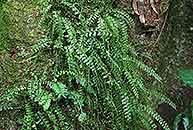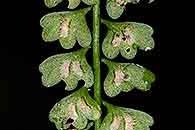Asplenium sandersonii Hook.
Synonyms |
Asplenium hanningtonii Baker |
|---|---|
Common name |
|
Description |
Rhizome (sub)erect, c. 3 mm diameter; rhizome scales brown, margin entire, lanceolate in outline, 2-4 mm long, apex gradually tapering to a point. Fronds tufted, arching, uniform, proliferous, fleshy. Stipe up to 4(-9) cm, subglabrous. Lamina pinnate, 5-30 × 1.5-4 cm, linear to lanceolate in outline. Pinnae 12-23 pairs, distally slowly decreasing in size and ending in a naked extension of the rhachis that bears a proliferating bud. Pinnae rhombic, midrib forming the basiscopic margin for some distance, basal margin entire, distal and acroscopic margins with broadly rounded lobes, base unequal, 0.6-2 x 0.3-1 cm, upper surface glabrous, surface below with a few brown scales. Rhachis straw-coloured, with narrow green wings, sparsely set with scales. Sori up to 8 per pinna, oval, covering most of the pinnae, to 3 mm long; indusium oblong, fimbriate, semi-transparent. |
Notes | Differs from similar species by the naked extension of the rhachis that bears a proliferating bud, pinnae with very rounded acroscopic margins. |
Derivation | sandersonii: named after J. Sanderson (1820-1881), an amateur plant collector in Natal. |
Habitat | Shaded areas in wet, evergreen forest and forest margins. |
Distribution worldwide | Africa, Madagascar, Comoro Isl. |
Distribution in Africa |
Angola, Burundi, Cameroon, Dem. Republic of Congo, Equatorial Guinea (incl. Bioko), Ethiopia, Gabon, Kenya, Malawi, Mozambique, Nigeria, Rwanda, South Africa, Sudan and South Sudan, Swaziland, Tanzania , Uganda, Zimbabwe. |
Growth form |
Epiphytic. |
Literature |
|





